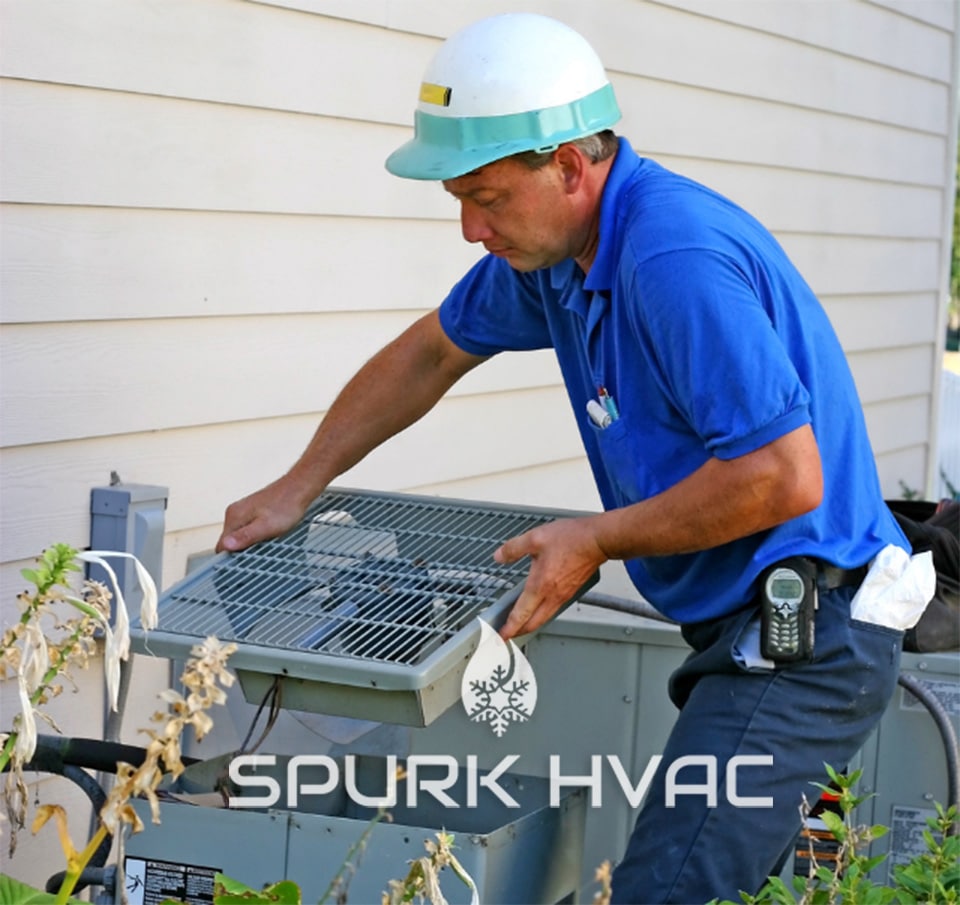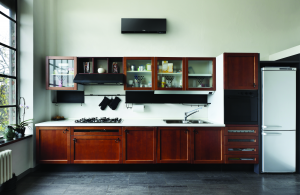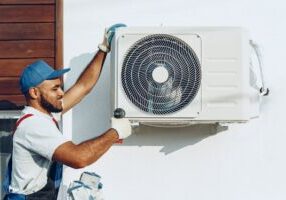If you’re looking for flexible heating and cooling options for individual rooms in your home, mini-splits can be the perfect fit.
In Pittsburgh, there are some homes that were built without any ductwork or limited ductwork which eliminates some heating and cooling options to certain areas of the building. We often see in some of the older communities and suburbs. Surprisingly, a vast majority of homeowners are unaware of this method of heating and cooling and how they can benefit from it.
As a Mitsubishi Electric Diamond Contractor, we’ve been working with, installing, and repairing mini-splits for years. In this article, we’ll explain what a ductless mini-split is, how it works, and why it’s different from traditional HVAC systems. Most importantly, by the end, you’ll have the information to decide if it’s the right system for you.
What Is a Ductless Mini-Split?
A ductless mini-split system does not need air ducts to operate (hence “Ductless”). A traditional air conditioner will distribute air throughout the home from a single unit. A mini-split indoor unit will service a single room or area, with each unit using a separate fan and evaporator coil.
In a less technical sense, mini-splits are a flexible solution for many residential and commercial buildings. They are hyper-efficient heating and cooling units that can control the temperature in hard-to-reach areas such as the upper levels of a home with no or limited ductwork that may not support heating or air conditioning.
The term “split” refers to the fact that there is still an outdoor and indoor unit as part of the system. The“mini” refers to the fact that the individual units, or “heads” are smaller than traditional A/C or furnace equipment and are placed in the actual room or area you wish to heat or cool.
What are some of the areas where you’ll traditionally see mini-splits in action? Let’s look at some of them:
- Garages – If you’re a person who spends a ton of time in their garage, you have experienced how sweltering the summer can be and how frigid the winter can be. That’s not a whole lot of fun. A ductless system will allow you to stay comfortable in your garage all year long. In fact, one of our clients is a local professional athlete who transformed his garage into a climate-controlled golf simulator with the help of a mini-split unit.
- Master Bedrooms – Often, these are the furthest rooms from a central heating and cooling system, and they suffer as a result. If your master suite isn’t being properly heated or cooled, sometimes a ductless solution is preferable to modifying the home’s ductwork or replacing the existing system.
- Finished Basements – Did you just turn your basement into the perfect entertaining space? It’s probably too cold most of the time, and too hot when you get a bunch of people down there even in the winter months. A mini-split could solve your problem/
- Attics/Guest Rooms – Similar to the basement, if you have a usable room on the upper level of your home, but it lacks air ducts traveling to it, you’ll often see mini-splits fill the void.
- Slab Homes, Condos, Patio Homes – Without a basement to house a larger air conditioner and/or furnace, these homes often lack good heating and cooling options.
Other features of ductless mini-splits include the following:
- They remove humidity. The evaporator coil in the unit will collect condensate, which drains out of your home. However, the reverse isn’t true. They can’t add humidity to a home.
- They filter your air. While the filtration isn’t always as robust as that of a whole-home system, cleanable filters in ductless systems will catch particulates to help keep your air clean.
Ductless systems still need regular maintenance and service, just like a full HVAC system. Their smaller size does not mean there is any less need to maintain the equipment.
How Does a Mini-Split Work?
Ductless mini-splits can always cool your air. Some models can also heat your home.
The heating/cooling combo systems function just like a heat pump (because it is).
Cooling-only units are rare in parts of the country that have a full four seasons of weather. Because it’s a heat pump, rather than generating heat to distribute through your home, it’s gathering heat from the outside to move into the home. This seems counterintuitive during the winter months. How can the system find heat outside when it’s freezing?
Despite how it feels to us, there is still heat in the air to absorb, and the technology can produce results even in these colder temperatures.
The other major factor in a mini-split system is how many indoor units, or heads, it has. This is one of the advantages of a ductless system. By having multiple heads, each functioning separately, you can use only what you need to keep you or your family comfortable, and no more. Saving potential arguments and money in the process.
One person wants it to be 74 degrees. Another wants it to be 68 degrees. Who wins? Obviously, the wife. Jokes aside, in reality, they both do. Each can control the temperature in their room accordingly. This is also one of the main advantages mini-split systems have over traditional central heating and cooling. Those larger systems can often service a whole home better, but don’t have the same level of granular control.
What Types of Mini-Splits Are There?
You’re probably most familiar with the wall-hung variety of mini-split that sits at eye level or above. Doesn’t that look out of place? It can, luckily, ductless systems have more variety, colors, and styles than this that can match the design of any room. Some examples include:
Wall-Mounted
Ceiling Cassette
Floor-Mounted
There are also options for ducted/hybrid mini split systems. For example, you can fit an air handler into some attics or crawl spaces and run ductwork to a particular area of the home, and pair it with a mini-split. This can be for things like home additions that aren’t in the same air duct system as the original house.
Residentially, ductless systems go up to 4-5 tons, which is a measurement of how powerful an outdoor unit is. A single-head mini-split that’s intended for a single room or area might only need a 0.5-ton outdoor unit, but a five-head split would require something in the upper tonnage range with a branch box to include a plethora of heads.
What Parts and Service are Different From Central Air?
Parts are unique to most types of HVAC equipment, so ductless systems aren’t unique in that regard. However, a few items that separate them.
The main filter on a mini-split can be removed, washed, dried, and re-inserted by the homeowner. However, cleaning other internal parts needs to be handled by a licensed Spurk HVAC service technician, who will have the equipment and materials needed to handle the process thoroughly and safely.
The filters also don’t catch the same level of germs or allergens as many whole-home air filters. There are carbon filters and small air purifiers that can be added to most systems that handle this function, but the carbon filters need to be replaced periodically or they will stop functioning efficiently, and any air filter will service a smaller area than a whole-home system, much like the mini-split itself.
Related: How often do I need to change my air filter?
Mini-Split Efficiency & Lifespan
Efficiency is where ductless systems can shine.
Many people have heard of SEER Rating, which stands for Seasonal Energy Efficiency Rating. It’s a calculation of how much energy it takes to cool your home to a certain degree. For heating, the acronym is HSPF, or Heating Seasonal Performance Factor.
Whole-home air conditioners can typically get up to about 22-23 SEER. The cooling in a ductless mini-split can be over 30 SEER! The same is true for HSPF, where ductless systems are among the most efficient machines on the market.
The primary reason for this is that mini-splits use inverter technology and a variable-speed compressor. The equipment takes high-voltage electricity coming in and converts it into DC voltage. This means less energy and more work.
The compressor’s variable speed also means that the airflow is matched to the temperature. Much like a dimmer on a light, it has more than an “on/off” switch. What this means is that it’s only using as much energy as it needs. By contrast, on most standard A/C units you have only one or two speeds, so the machine turns on and off more often.
Mitsubishi Electric mini-splits also come with room sensors to gauge temperature and hot or cold spots. In this way, they can automatically adjust to stay at a certain comfort level.
This is the highest level of technology built into an HVAC system. However, it still requires regular maintenance to continue running efficiently. Properly maintained, you can expect 12-15 years on average from your system, or more on occasion.
Is DIY a Good Option?
You’ve probably seen the commercials or Facebook ads that talk about purchasing and installing your own ductless system. While any decision about your home heating and cooling is ultimately yours to make, there are several risks to be aware of with this option.
With a licensed, trained HVAC contractor, you’re going to have equipment that’s installed to manufacturer code, tested, and commissioned to ensure proper efficiency, and maintained for the life of the system to make sure it stays efficient.
By contrast, you have none of those assurances with a self-installation. The equipment won’t be warrantied, finding parts can be a hassle (or impossible) in case it breaks down. If you have to turn to a contractor for repairs, there’s no guarantee they’ll be able to secure parts either, which are often specific to the make and model of a unit.
Homeowners often underestimate the complexity of installations as well. There are elements of carpentry, electrical work with high-voltage wiring, working with flammable and combustible materials, and the use of open flames for brazing (a form of welding). If you get into a pinch, you’ll be hard-pressed to find a contractor willing to finish the install. We won’t touch it and many of our friends in the industry won’t either.
Beyond that, much of the equipment required to perform each of those tasks is highly specific and sometimes very expensive. Do you have all the proper tools, know how to use each, and want to buy them for a one-time installation? Many of the units for sale online for DIY installation don’t come with all of the proper tools, and sometimes don’t include all primary parts required for it to fully function.
There’s a myth that HVAC equipment is much like an appliance: just plug it in. This is not the case. The skills, training, and tools required to guarantee a responsible installation are not things the average homeowner has.
If an HVAC contractor makes a mistake during installation, it won’t cost you a dime. Good contractors will carry a labor warranty and will make things right if they make a mistake. If you make a mistake, though, there’s no safety net.
Related: Why you shouldn’t DIY Your HVAC System, Benefits of a High-Quality Installation
Who Should Consider a Mini-Split? – Are You a Good Candidate?
If you have a slab home or older home with no ductwork, the cost of installing ductwork can sometimes exceed the cost of an air conditioner and furnace. If you need heating and cooling for your home in these instances, you should explore both ducted and ductless options.
Who else should be considering one? If you have any “nuisance” areas in your home, this is the first clue that a mini-split might be right for you. We discussed some of them earlier: Garages, patios, sunrooms, home additions, guest rooms, attics, or others like this. If these rooms run hot or cold too often or don’t have ductwork running to them, they’re ideal candidates for a ductless system.
For the tech-savvy, ductless systems offer some of the most advanced technology in HVAC currently available. Using the internet of things and a little IFTTT, you can transform your home into a smart and comfortable oasis.
Related: Smart Air Conditioning: Buyers Guide
Savings
The cost savings can be immense over 12-15 years due to the equipment’s efficiency. Your comfort level will increase dramatically. Single-head units start at around $5,000 for equipment and installation, but the cost can climb from there depending on several factors, including the types of heads being installed and how many heads your system has.
Lastly, even if you’re just interested in the cooling properties of mini-splits, always consider ones that both heat and cool. The cost difference is usually minimal, and you can’t retrofit a cooling-only unit to do heating once it’s installed.
What’s Next?
If you’re interested in a mini-split or not sure if you’d be a good candidate for one, give us a call or click the button below to schedule your free consultation. Our expert estimators will help you find the best possible solution for you.
Book Now
ABOUT SPURK HVAC
Spurk HVAC was formed in 2018 and is located in Warrendale, Pennsylvania. We proudly serve Cranberry Twp., Wexford, Gibsonia, Mars, and the surrounding Greater Pittsburgh area.
We service all makes and models. If you are seeking a heating repair, heating system replacement, air conditioner repair, air conditioning maintenance, air conditioning replacement, or any other heating & cooling services. Whether you are looking for residential or commercial HVAC services, we look forward to any and all opportunities to become your preferred HVAC contractor.














